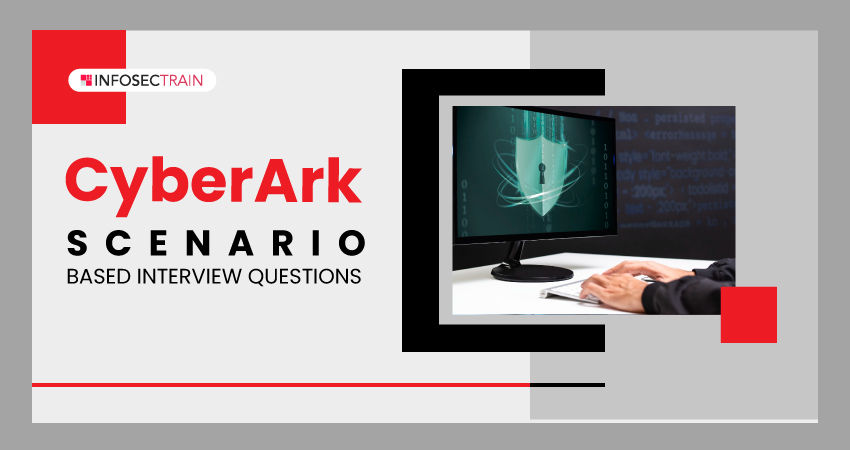CyberArk Scenario Based Interview Questions
In today’s fast-paced digital environment, safeguarding sensitive data and valuable assets is a top concern. As organizations increasingly depend on technology to store, manage, and transfer their most valuable information, the need for strong cybersecurity defenses cannot be underestimated. Among the leading cybersecurity providers, CyberArk is one of the top names in privileged access security solutions. CyberArk’s software and services protect your organization’s most valuable assets, especially privileged accounts and credentials, from cyber attacks.

As the demand for skilled CyberArk professionals grows, in-depth interview preparation is imperative. Employers often conduct CyberArk scenario-based interviews to test a candidate’s real-world cybersecurity expertise and problem-solving skills. In this article, we delve into the CyberArk scenario-based interview questions that will assist candidates in successfully navigating interviews and landing their dream job.
CyberArk Scenario Based Interview Questions
1. You have just added a new critical application to CyberArk, but the application team reports that password rotation is not working. How would you fix this issue?
To troubleshoot a password rotation failure for a critical application in CyberArk, we can follow these steps:
- Verify that the application credentials stored in CyberArk are accurate and up-to-date
- Examine the password rotation policy and platform settings to ensure they comply with the application’s requirements
- Check the notifications and logs in CyberArk for any anomalies or error messages related to the rotation process
- Analyze the application logs for specific error messages or issues during password rotation attempts
- Verify that the application team has the required permissions and privileges to start password rotations
- Start a password rotation manually to test if it fails and get further error information
- Collaborate with the application team to understand any recent password rotation changes or issues
- Make sure the application’s documentation matches the configuration
2. Suppose a user reports that they cannot access a specific privileged account via PVWA (Password Vault Web Access). Explain how you would diagnose and resolve the issue.
To address a user’s inability to access a privileged account via PVWA, we can follow these steps:
- Verify User Credentials: Verify the user’s login credentials to ensure they are accurate
- Verify Account Status: Verify whether the privileged account is active or locked
- PVWA Health: Ensure the PVWA service is running
- Review Access Permissions: Ensure the user has the necessary permissions to access the account
- Logs and Error Messages: Analyze logs for any errors or access denials, addressing them accordingly
- Browser Compatibility: Verify that Password Vault Web Access is compatible with the user’s browser
- Password Policy: Confirm the password complies with policies and has not expired
- Password Reset: Reset the password if necessary, then test access
3. Let’s say you have been tasked with configuring a new CyberArk safe. What would be the most important factors you consider when setting up access controls for your new safe?
When setting up a new safe in CyberArk, consider these key factors:
- Authorization: Define who can access the safe and their roles (admins, users, auditors)
- Authentication: Implement the appropriate authentication methods, such as MFA (Multi-Factor Authentication), SSO (Single Sign-On), Biometric Authentication, etc
- Least Privilege: Assign permissions based on the least privilege principle to limit access to only what is essential
- Emergency Access: Prepare access policies and approval processes for emergencies
- Audit Trails: Enable thorough auditing to monitor safe activity.
- Rotation Policies: Implement password management and rotation policies
- Segregation of Duties: Avoid conflicts in access permissions by separating responsibilities
4. A company wants to secure its AWS root account during a cloud migration using CyberArk. What approach would you use here?
To secure the AWS root account with CyberArk during a cloud migration, we should consider the following things:
- Isolate AWS root credentials within the CyberArk vault
- Implement automatic password rotation for the root account
- Define strict access policies and permissions for who can retrieve and use these credentials
- Implement session recording for all root access
- Set up alerts for suspicious activities
- Enable Multi-Factor Authentication (MFA) for root account
- Monitor and analyze audit logs for security breaches
5. During an audit, it was discovered that a group of users had unauthorized access to a set of privileged accounts. How would you investigate how this occurred, and what actions would be taken to rectify the situation?
Following the steps below, we can effectively investigate and mitigate unauthorized access to privileged accounts.
- Immediate Response: The first step should be deactivating compromised accounts and updating passwords for impacted privileged accounts
- Gather Evidence: Collect logs and audit trails related to unauthorized access
- Identify Affected Accounts: Determine which privileged accounts were accessed without permission
- Root Cause Analysis: Investigate how the breach happened, looking for vulnerabilities or misconfigurations
- Patch and Remediate: Address identified security vulnerabilities or misconfigurations
- Review Access Controls: Assess access policies and permissions to identify security gaps
- Report and Documentation: Document the investigation process, findings, and remediation steps. Inform management and affected parties about the breach and remediation steps
6. A user attempts to access a password via the PVWA but encounters an error stating they are not part of the necessary access group. The user claims they successfully accessed the same account just last week. How would you handle this situation?
In this situation, we could follow these steps to handle the issue:
- Verify the user’s claim of previous access to ensure accuracy
- Check to see if the user was a part of the necessary access group last week
- Examine recent modifications to access groups or user permissions that may have led to the error
- Analyze access logs and audit trails to find anomalies or errors during the attempted access
- If required, modify the user’s permissions or access group to allow appropriate access
- Provide user guidance or training if the issue is due to a user mistake
7. Suppose you have been given a task to integrate CyberArk with the SIEM system for central logging and tracking. What steps would you take, and what would you consider?
To integrate CyberArk with an SIEM solution for centralized logging and monitoring, we should follow these steps and considerations:
- Planning: Define data requirements and integration objectives
- Select SIEM: Select a compatible SIEM solution that CyberArk supports, ensuring it can accept logs and events
- CyberArk Connector: Install a CyberArk connector or agent to collect data
- Data Mapping: Define which CyberArk events and logs should be sent to the SIEM for analysis
- Access Policies: Ensure logs include privileged access and authentication events
- Testing: Test the integration to ensure accurate correlation, SIEM alerting, and data transmission
- Alerts and Dashboards: Create custom alerts and dashboards in the SIEM for CyberArk-related events
- Continuous Monitoring: Implement real-time monitoring and regular review of SIEM alerts and logs
- Documentation: Maintain complete documentation for future reference
8. A critical system is down, and the team suspects it is related to a password change made via CyberArk. How would you check if CyberArk caused the issue? What actions would you take to resolve the issue?
To verify if CyberArk caused the critical system outage:
- Check CyberArk logs for any password update activities related to the affected system.
- Check the system logs on the crucial system for any errors or anomalies that coincided with the password change.
- To comprehend the procedure and identify any possible issues, interact with team members engaged in the password update.
If CyberArk is confirmed as the cause, then we should follow the below steps to resolve the issue:
- Initiate a password rollback to the previous state to restore system functionality.
- Investigate why the password update caused the issue and address any misconfigurations or vulnerabilities.
- For future reference, document the event, findings, and remediation steps.
- Implement preventive measures to avoid identical incidents in the future, such as enhanced testing and validation methods.
- Throughout the process, keep stakeholders updated on any resolutions or preventative measures taken.
9. The organization is worried about the risk of insider threats and wants to set up session recordings for specific privileged accounts. What would be the best way to implement this in CyberArk?
To reduce the risk of insider threats, implement session recording for specific privileged accounts in CyberArk using these simple steps:
- Identify Target Accounts: Based on criticality and access levels, identify privileged accounts that need session recording.
- Session Recording Policy: Establish a clear session recording policy that outlines what should be recorded, how long it should be kept, and who may view the recordings.
- Configure PSM (Privileged Session Manager): Install and configure CyberArk’s PSM to enable session recording.
- Storage and Access Control: Create a secure storage for session recordings and restrict access to only authorized personnel.
- Retention Period: Establish a session recording retention term that complies with organizational policies and legal requirements.
- Monitoring and Alerts: Configure alerts and monitoring to identify suspicious activities during sessions.
- User Awareness: Educate privileged users about the session recording procedure and its intent.
- Record: Record all aspects of the setup, including configurations, policies, and procedures.
10. If you are asked to import 100 new Unix-based servers into CyberArk, explain how you would go about it and what challenges you might face.
To import 100 new Unix servers into CyberArk:
- Gather a list of servers with their details (e.g., IP, hostname, OS, etc.)
- Establish a separate safe for Unix servers
- Create privileged user accounts for every server
- Use CyberArk’s automated discovery tools to identify and validate account information on servers
- Confirm successful discovery and account integration
- Apply appropriate access policies and permissions
- Verify access to ensure successful integration
Challenges may include:
- Coordinating server access
- Managing credentials securely
- Ensuring uniform configurations
- Handling potential errors during the import process
- Setting up appropriate permissions for users
Related Blogs:
- What is CyberArk?
- CyberArk Use in Enterprise
- Key Features of the CyberArk
- Reasons to “Enroll” at CyberArk with InfosecTrain
- CyberArk Interview Questions and Answers
- SailPoint vs. CyberArk
CyberArk Training with InfosecTrain
At InfosecTrain, we offer a CyberArk online training course, equipping individuals with the knowledge and skills required to construct, implement, and set up the privileged account security solution effectively. Learners will acquire practical experience setting up CyberArk infrastructure, specifying authentication methods, and other related tasks. Our offerings include instructor-led training, access to recorded sessions, as well as interview preparation sessions that will assist individuals in their professional development and job-seeking endeavors.







 1800-843-7890 (India)
1800-843-7890 (India)